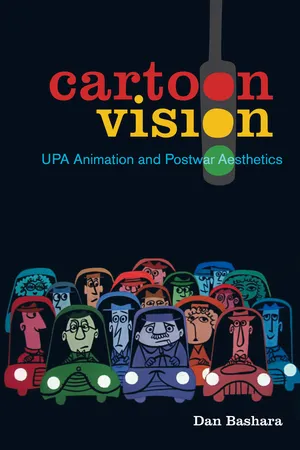
- 296 pages
- English
- ePUB (mobile friendly)
- Available on iOS & Android
About this book
In Cartoon Vision Dan Bashara examines American animation alongside the modern design boom of the postwar era. Focusing especially on United Productions of America (UPA), a studio whose graphic, abstract style defined the postwar period, Bashara considers animation akin to a laboratory, exploring new models of vision and space alongside theorists and practitioners in other fields. The links—theoretical, historical, and aesthetic—between animators, architects, designers, artists, and filmmakers reveal a specific midcentury modernism that rigorously reimagined the senses. Cartoon Vision invokes the American Bauhaus legacy of László Moholy-Nagy and György Kepes and advocates for animation's pivotal role in a utopian design project of retraining the public's vision to better apprehend a rapidly changing modern world.
Frequently asked questions
- Essential is ideal for learners and professionals who enjoy exploring a wide range of subjects. Access the Essential Library with 800,000+ trusted titles and best-sellers across business, personal growth, and the humanities. Includes unlimited reading time and Standard Read Aloud voice.
- Complete: Perfect for advanced learners and researchers needing full, unrestricted access. Unlock 1.4M+ books across hundreds of subjects, including academic and specialized titles. The Complete Plan also includes advanced features like Premium Read Aloud and Research Assistant.
Please note we cannot support devices running on iOS 13 and Android 7 or earlier. Learn more about using the app.
Information
Table of contents
- Subvention
- Title
- Copyright
- Dedication
- Contents
- List of Illustrations
- Acknowledgments
- Introduction
- 1 • Postwar Precisionism: Order in American Modernist Art and the Modern Cartoon
- 2 • Unlimited Animation: Movement in Modern Architecture and the Modern Cartoon
- 3 • Condensed Works: Communication in Graphic Design and the Modern Cartoon
- 4 • The Design Gaze: Cartoon Logic in Hollywood Cinema and the Avant-Garde
- Conclusion
- Notes
- Bibliography
- Index